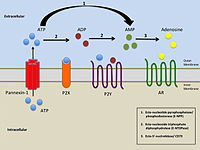Ectonucleotidase
| Part of a series on |
| Purinergic signalling |
|---|
 |
| Concepts |
| Membrane transporters |
|
Ectonucleotidases consist of families of
purinergic signaling depends on the availability and preference of substrates and on cell and tissue distribution.[1]
Classification
Subfamilies of ectonucleotidases include:
CD73.[1]
Function
Ectonucleotidases produce key molecules for purine salvage and consequent replenishment of ATP stores within multiple cell types. Dephosphorylated nucleoside derivatives interact with membrane transporters to enable intracellular uptake. Ectonucleotidases modulate
P1 receptors.[2] In addition, ectonucleotidases generate extracellular adenosine, which abrogates nucleotide-mediated effects and activates adenosine receptors, often with opposing (patho-) physiological effects.[3]
Adenosine generation
The first step in the production of adenosine involves the conversion of ATP/ADP to AMP. It is carried out by ENTPD1, also known as CD39. The second step involves the conversion of AMP to adenosine. It is carried out by NT5E, also known as CD73.[4]
References
